Suzan Mazur: Betsey Johnson, 2nd Skin & Darpa $$$
Betsey Johnson, 2nd Skin & Darpa $$$
By Suzan Mazur
RELATED STORIES:
- Futurist Giorgio Sant' Angelo, An Hommage
- Geoffrey Beene, Spacewear & DARPA $$$
- Bill Blass -- Into The Retro Future
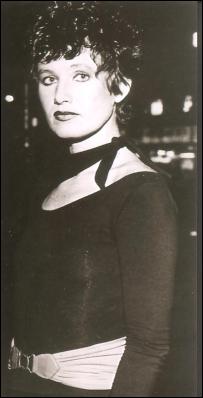
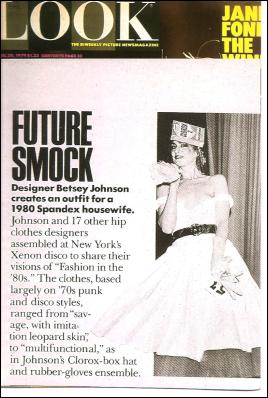
Designer Betsey Johnson (l) - photo: John Murphy '79, and Suzan Mazur (r) modeling Betsey's clothes at Xenon -- photo: Roxanne Lowit, Look magazine, '79"
"They have to stop it from being fashion. And stop it from being clothes. Stop it from what it is now and make it unparanoid, unafraid. I think basically people are afraid of clothes now. . . . It has to get down to a highly computerable, biodegradeable uniform that can be spat out or molded on It has to be that simple." -- Betsey Johnson
On the heels of the public symposium on "humans in space" held in Orlando earlier this month, DARPA will award $500,000 next month to individuals and organizations with the best ideas on the subject. Futuristic designer Betsey Johnson had some thoughts along these lines during our interview for Omni magazine, and so I've gone back to the audio tape for this story.
As I recall, when we spoke at Un Deux Trois restaurant in February 1979, Manhattan was very cold and raw, particularly downtown on Bleecker Street where sidewalks were broken and iced over, signalling far too many commercial vacancies. New York had been told by Washington to "drop dead" regarding its request for federal assistance to stave off bankruptcy a few years earlier and was now shuffling along like a bag person. And while there were no major street protests as there are now, there was plenty of discontent -- the rents having quadrupled in the decade of the '70s driving creative talent to occupy the warehouses of Soho and Tribeca. But the clubs were ALIVE, Woody Allen was celebrating Manhattan on the big screen, Saturday Night Live was funny, and Betsey Johnson -- already electric -- was further turned on by Punk Rock.
A child of the
'50s and '60s, Betsey continued to be a child of the '70s,
and then the '80s, '90s, '00s, and is still cartwheeling
down the fashion runway at age 70.
I met Betsey through
my friend Honey Wolters, then a stylist for
Soho News, who thought Betsey was on to something and
suggested I stop by her Downtown studio.
Meeting Betsey Johnson was like encountering Malcolm Forbes, an immediate infusion of happiness. She was in love with Omni magazine, second skin clothing, the Warhol crowd, and the rest of humanity.
I decided to introduce her to my Kuwaiti friend Mahmoud Alghanim, who had gone to school in California in the '60s and had several of Andy's soup can pencil sketches on the walls of his home in Kuwait. Mahmoud too thought Betsey was on to something, was amused by her zebra-striped dresses and ordered lycra stretch uniforms for his British Airways office in Kuwait.
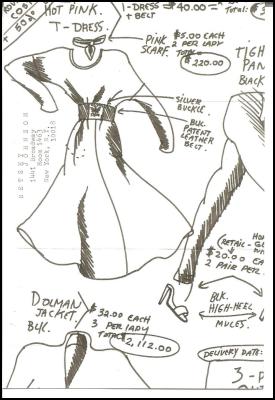
Click for big version
Betsey Johnson invoice
Betsey was indeed plugged in. Without incident, I wore her clothes in the souks of the Arabian Gulf, in East and West Africa en route to interview Mary Leakey (I was told by Polish ex-pat George Mankowski, who ran an office in Nigeria for key American mining concerns, that no one as colorful had been through Lagos in 10 years), and in and around the ancient ruins of the Aegean. Betsey's red lame' dress even brightened the Christmas of New York Giants Quarterback Joe Pisarcik, who greeted me on crutches at the door of his parents' home in Pennsylvania following his infamous game with Philadelphia, for an interview about future sports.

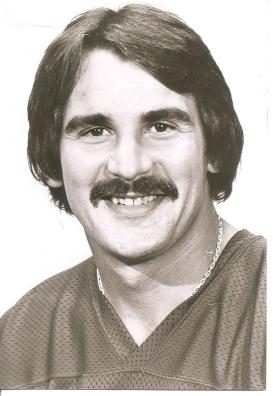
Suzan Mazur (l), New York Giants Quarterback Joe Pisarcik (r), 1978
I modeled in Betsey's shows at Mudd Club, Inferno, Xenon and Heat, where Andy Warhol's Retrospective of Betsey Johnson was shot for Manhattan Cable TV.
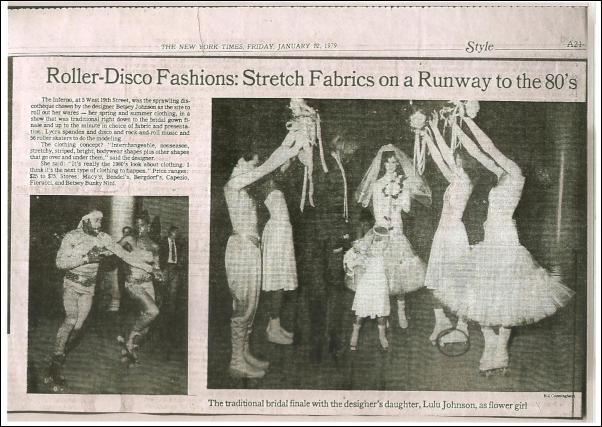
Click for big version
Betsey Johnson's Roller-Disco Wedding, Suzan Mazur -- bridesmaid (circled skate), New York Times '79, Photo: Bill Cunningham
My interview with Betsey Johnson follows:
Suzan Mazur: This is the newest version of the spacesuit.
Betsey Johnson: Fabulolus. Looks glued together . . . like Michelin Man.
Suzan Mazur: Over the underwear there's a layer of Nomex. On top of that, venous-like plastic tubing for water to circulate to cool the body. And over that several layers of mylar, aluminized mylar, and a coating of Nomex teflon to protect against radiation. NASA is trying to reduce the thickness.
Betsey Johnson: Looks very
Bauhaus, 30s, 40s. Did you hear Orson
Welles
and
Robert
Blake on
Merv Griffen the other night? Very intense.
Suzan Mazur: What did they say?
Bestsey Johnson: Blake sees the complete disintegration of people who care. Welles actually felt the same way. They think responsibility, commitment, that simple form of caring is just gone.
Suzan Mazur: Desperate times. There's no money.
Betsey Johnson:
Welles was against the space trip. He said what about all
the starving people on this planet?
But I think you
can't just stop development. You've got to work on
everything, altogether.
Every Wednesday is my night Mudd
Clubbing and rollerskating at Empire. My check-it-all-out
night. Rollerskating's very spacey -- the speed -- CHOOWHEW.
Stay in touch with me about the Mudd Club
show.
Suzan Mazur: Will the growing desire for functional clothing bring about a marriage of the fashion designer and engineer? Will today's ready-to-wear- designer go the way of the couturier?
Betsey
Johnson: There's going to be such a total change.
The garment district and sewing machines and cloth that you
cut with scissors, that you sew with thread will all be
obsolete. There's going to be a complete flip, a reverse.
Space-age type clothing. A total combination in space of all
the elements I wish fashion could be now.
On Earth, there
will still be ready-to-wear, clothing bound by the
limitations of this planet. I think the clothes I'm doing
now could be worn on Earth in the year 2000, 3000, 4000. And
there will be clothes for space wear.
Suzan Mazur: Your current collection could be worn on Earth in the year 3000?
Betsey Johnson:
Yes, because Earth is a natural planet. We don't have
control over Earth as we would a space station.
The
designer, the person visually involved with clothing, will
always be part technician. . . . I think there'll be
technicians who are involved in the production of clothes in
the future and then people who accept the given technical
layout. The engineers will lead, it would occur to them to
include the designers. . . . But the idea of a fashion
designer, a clothing designer is something that doesn't have
to exist.
Suzan Mazur: With the non-biodegradeable quality of synthetic fiber still very much a problem for the near future and considering the diminishing quantity of natural fiber, with what material do you intend to clothe people in the future.
Betsey Johnson: In the near future? I want it to come across, Suzan, that I am clothing those people right now. Most of my line is synthetic fiber. The future to me is part of what I'm doing now. The combination of synthetic lycra with cotton still really sells the best because people really do relate to naturals. I just don't think it's future anymore. Natural fibers are super expensive, super luxurious.
On Earth things will be cyclical. A future trend in clothing for 10 years. Then past for 10 years. Future for 10 years. Past for 10 years. That's the way I think this planet will go. Once we get into space, it's pure future, which is real exciting.
Suzan Mazur: The thinking is that once we begin living in space, Earth will be for recreation, a nature preserve. In space colonies, conditions will be ideal. Although, Giorgio Sant' Angelo told me he thinks life inside a space colony, as currently envisioned, "is for bankers".
Betsey Johnson: Totally controlled environment. . . . I see my work as color sculpture. As interchangeable color shapes that are timeless, seasonless, ageless. They have all the elements of future, simple concepts. These designs are difficult for people to appreciate after all the silk shirts, ties and tweed blazers we've become accustomed to. What I'm experiencing is that people don't see the purity of design, it's hard to get people back to that kind of simplicity. They have to see it in the arts. They have to see it in the buildings. . . . It's a total flip.
What I'm trying to do is begin this excitement of shape, color and synthetics at the daycare center level, in kindergarten and first grade http://www.scoop.co.nz/stories/HL0809/S00183.htm. People have said we want this. They understand the value of this approach because of Danskin bodywear, which is so totally anti-fashion. I think future clothes are really anti-fashion because they're based on life, not on history. The fashion business is based on the history of Paris couture, on an Avenue or designer telling a woman what to wear instead of people wearing clothes based on their own lifestyle.
It's Halston used charmeuse, so everyone's onto charmeuse. How about -- out of my life comes what I want to wear? Independently everyone knows what they want to wear.
Suzan Mazur: It's true. Clothes are complicated at the moment.
Betsey Johnson: This
industry isn't about conceptual thinking. It's about what
was the best checkout last season. In attempting this
futuristic approach now, I see how far away from the future
we really
are.
Suzan
Mazur: You're going to continue using synthetic
fabric.
Betsey Johnson: Totally.
Suzan Mazur: Even though there's a problem with what to do with nonbiodegradeable synthetic clothes after they're tossed? They wind up polluting the environment. There isn't enough funding behind the move to reclaim chemicals from disgarded synthetic clothes.
Betsey Johnson: We are reclaiming natural fiber to make clothes.
Suzan Mazur: People have to put pressure on government and the textile industry to fund this reclamation. The oceans are polluted, etc.
Betsey Johnson: Government has to take responsibility to complete the cycle. I think the ideal clothing for the future is uniformed clothing. My clothes now are uniforms. I've worn these two shapes like a uniform for about six months now. They're never boring or unreflective of me. I never feel restricted.
Suzan Mazur: People seem energized by your clothes.
Betsey Johnson: It's a
shock for people to see that simplicity. They're not seeing
clothing. They're seeing you. But how is it that pure
simplicity is so shocking?
It was very shocking to hear
Robert Blake say the big problem is nobody really cares.
Such a simple idea. How screwed up we are by big business
and the dollar. Seventh Avenue is a dollar grind. It's hype
to keep people in business. I look around and I see people
looking so terrible as a result. The saddest thing to me is
the industry making everyone look so bad. . . .
Teach children to think for themselves. Pick clothes related to what they love doing. Begin with the parent giving this new important information to the child. Business has to see a whole different picture, from which it could just as easily make money. Simplicity is future and modern. Retro, the past, is complex and nostalgic, and melancholic and layered.
Suzan Mazur: One of the things regarding space colonization is the importance being placed on the presence of children. Animals. Crops. Continual feeling of growth.
But in an environmentally inhospitable future here on Earth, what kind of second skin clothing do you envision?
Betsey Johnson: I don't think the answer would be what you wear. . . . It's bigger than Seventh Avenue. Seventh Avenue is Harper's Bazaar, Vogue business. It has nothing to do with life.
When the Earth does get so screwed up environmentally, clothing will finally become what it should be, things that directly relate us to our environment. We are not doing that. I thought we did it to an extent in the '60s. The '70s have been disruptive. We've wanted to be nostalgic. Not face the future. Feel comfortable going back to the past. Now clothing is a luxury issue, not a survival issue. I hope this whole BS picture on the wall thing is over with, because it is a problem of human survival.
In the totally controlled uniformatic space colony situation of the future, I think preserving the idea that each person is uniquely different from every other person is crucial. . . Since people's homes will be controlled, their food controlled, environment controlled, air they breathe controlled, I hope clothing is then -- as I wish it were more now -- an area of creative individual expression.
Suzan Mazur: What kind of clothes would you like to see being worn there?
Betsey Johnson: I've always liked the idea of a clothing store being like the cockpit of an airplane, a real self-service computerized little cockpit that you go in and press all the buttons. And your body is read, your emotions, all that is read. And that's second skin. I really believe it's still a very elastic second skin thing in the future but that doesn't mean it has to be body-like. I like the idea of shapes beyond the body contrasting with body shape. I hope there's always a vehicle for people to be as visually and personally interesting as possible. It has to get down to a highly computerable, biodegradeable uniform that can be spat out or molded on. It has to be that simple.
Suzan Mazur: When I wear your clothes I do feel like I'm wearing a very spontaneous message.
Betsey Johnson: People think by their complex dressing that they look very different, but that's not true. If everyone put on the same uniform, we would finally see the differences. Because in that simplicity, you stop looking at the clothes and start looking at the faces and the expressions and the movement. There still should be the freedom of color choice, shape choice, material. Whether you want a metallic reflective substance or a mat. I think clothing in the future should be much more related to personal, private feelings. Presently the approach is not to think about clothing as an extension of our lifestyle and our environment.
Every other cycle of years people like Rudi [Gernreich], like Claire McCardell, and me when I'm working in my true statement -- not people like Calvin Klein. . . The industry has conditioned people to follow what Fashion Avenue and Paris dictate. Clothing in space should be totally related to our emotions not something impersonal like "Annie Hall" and a menswear look for women. This is simply not wanting to recognize that we are women.
There should be a rich variety in the future. On this second skin uniform there may be a hundred buttons you can press for creative personal expression. They have to stop it from being fashion. And stop it from being clothes. Stop it from what it is now and make it unparanoid, unafraid. I think basically people are afraid of clothes now.
Suzan Mazur: I do forget about clothes when I'm wearing your clothes.
Betsey Johnson: My clothing is difficult for a lot of people to wear, because you do get looked at. It's like a stripping yourself bare. Like taking it all off. Like going out there unclothed.
Suzan Mazur: A person's body makes sense to itself. If you put Orson Welles in your second skin clothes, you would better understand the man.
Betsey Johnson: What I'm doing is very present, but conceptually very future. It's frustrating because it's moving mountains. That's why the idea of this finally happening in space, as much as I'd love it to be tomorrow, seems so far away. Because of what I'm trying to make happen now and seeing how far away that is.
Suzan Mazur: Do you envision our energy dependence on Mid East oil retarding our culture?
Betsey Johnson: When the going gets tough, people want fantasy. That's why I think as we go into a very depressed era, we see the emergence of Star Wars, Close Encounters, man-made fiber, plastique, Rock 'n Roll. People get boring in good times, like the Eisenhower years. We have to create something fun to balance the depression now. This next cycle has not come from fun, it's come from lack of fun. The last eight years has not been fun. It's been investment -- buy your blue chips now because in 10 years you might not be able to afford them. It's been a scared existence.
Suzan Mazur: The US has in the past heavily influenced world events because we've been rich, but now there is a buying up of America from abroad.
Betsey Johnson: The big picture is the world. You can't make it in the future just on your piece of land. . . Fabulous wonderful change happens when thing get as bad as they can get.
I'm seeing more
resentment towards my work now than when I opened. Saks
Fifth Avenue and Lord & Taylor do not want to let go and let
this new world happen.
People don't take the ozone issue
seriously until they're dropping in the
street.
Suzan Mazur: On the other hand, women from the L-5 Society (http://www.nss.org/settlement/L5news/L5history.htm), the space colony group, are saying they won't have babies until they're in space.
Betsey Johnson: Space colonies are going to be a very elite, isolated existence. Like life depicted in Vogue and Harpers in the 30s. Not for most people of this planet. Space will be the plaything of the so rich, an elite, money, money, money kind of thing.
Suzan Mazur: But it's being projected as the new frontier. The mining of asteroids in space. There will have to be workers, miners and the mining rush culture that comes with it. So maybe not all elitist.
What kind of clothes could be created to encourage mating?
Betsey Johnson: I don't want to believe that our relationship to one another as human beings is going to have to be supported by contraptions, by accessories, that flash off and excite. I'm really against that. It's really sad if we ourselves become computers. The flashing light is going to get boring. What it really comes down to is simple, private and I think private is very, very imporant. Because I think the greatest people are lonely, private people. As soon as information is mass information -- it's not so interesting anymore. To encourage mating, to me is to have children around and to acknowledge the greatness of children.
The question is how do we get people to simply want to relate to one another as male and female. It isn't going to be created by anything we wear, it has to be created by how we think and feel. It is a head, brain, sensitivity thing.
Suzan Mazur: What sort of costumes would you create for a ballet performed in a space colony on a one-tenth gravity stage?
Betsey Johnson: Light is a costume. Space is a costume. Elevation. The last thing I would think about is cut and sewn costumes. You're dealing with a situation where there isn't an audience and stage anymore. The audience and the stage are one. It would depend on the composition of the music, which would have to relate to the composition of the light, which would have to relate to the composition of the space. People would fly.
You could have a people ceiling that nobody knew was a ceiling until people came off it. A chameleon effect, where at one point a dancer is part of the space and then disappears someplace else. Costumes would either be second skin, if you need clothing, because these could deal with air currents. But I think any fabrication might be old fashioned. I would start with a base of no clothes. Let the emotion of the music dictate. Unless there was no music. If there was a body covering, it would be second-skin that maybe could be blown up huge like bubble gum. One moment it's second skin and the other it's a whole shape around them. The substance of the second skin has to be totally able to change with light, with air, with music. Maybe the clothes give off music. A certain sound is made and this totally changes the color of the clothes. It's beyond what we can really imagine.
Suzan Mazur: Are you thinking about heat molded clothing now?
Betsey Johnson: That's what I would like to do, molded clothing. I'd like to cut the sewing machine out because synthetic fiber is totally meltable, fusable. It shouldn't be sewn. If it's plastic, you mold it, you shape it. I don't want fabric, I want a molding machine now. In the future, I'd like to forget about fabric, give my specs and there'd be this molded second skin body suit. No cutting and sewing. And I would love everyone to know what they would like to wear. It's totally not believing in fashion designers.
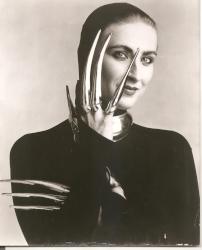 Suzan
Mazur is the author of The
Altenberg 16: An Exposé of the Evolution
Industry. Her reports have appeared in the
Financial Times, The Economist, Forbes,
Newsday, Philadelphia Inquirer,
Archaeology, Connoisseur, Omni and
others, as well as on PBS, CBC and MBC. She has been a
guest on McLaughlin, Charlie Rose, and various
Fox Television News programs. For some years along the way,
she was a runway fashion model for Giorgio Sant' Angelo,
Geoffrey Beene, Bill Blass and other legendary designers.
Email: sznmzr@aol.com(photo
credit (l): Matthew Klein '79 )
Suzan
Mazur is the author of The
Altenberg 16: An Exposé of the Evolution
Industry. Her reports have appeared in the
Financial Times, The Economist, Forbes,
Newsday, Philadelphia Inquirer,
Archaeology, Connoisseur, Omni and
others, as well as on PBS, CBC and MBC. She has been a
guest on McLaughlin, Charlie Rose, and various
Fox Television News programs. For some years along the way,
she was a runway fashion model for Giorgio Sant' Angelo,
Geoffrey Beene, Bill Blass and other legendary designers.
Email: sznmzr@aol.com(photo
credit (l): Matthew Klein '79 )


 Martin LeFevre - Meditations: Animal Encounters During Meditative States
Martin LeFevre - Meditations: Animal Encounters During Meditative States Ian Powell: Gisborne Hospital Senior Doctors Strike Highlights Important Health System Issues
Ian Powell: Gisborne Hospital Senior Doctors Strike Highlights Important Health System Issues Keith Rankin: Who, Neither Politician Nor Monarch, Executed 100,000 Civilians In A Single Night?
Keith Rankin: Who, Neither Politician Nor Monarch, Executed 100,000 Civilians In A Single Night? Eugene Doyle: Writing In The Time Of Genocide
Eugene Doyle: Writing In The Time Of Genocide Gordon Campbell: On Wealth Taxes And Capital Flight
Gordon Campbell: On Wealth Taxes And Capital Flight Ian Powell: Why New Zealand Should Recognise Palestine
Ian Powell: Why New Zealand Should Recognise Palestine